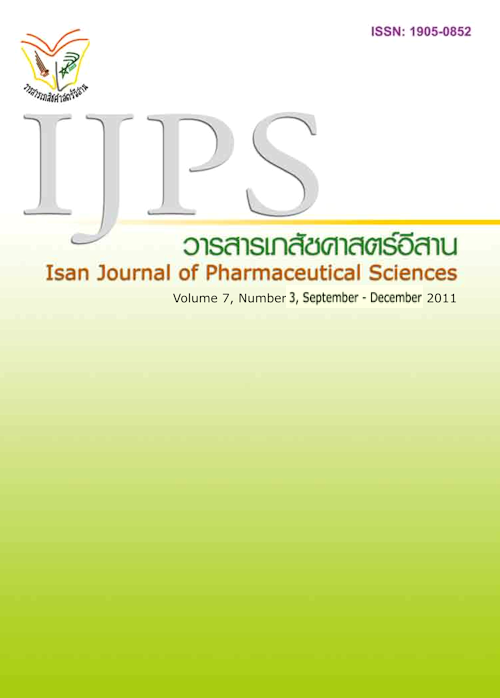Comparison of human and porcine skins as the barrier membraneinan in vitro permeation of plant polyphenols
Main Article Content
Abstract
Introduction: Porcine and human skin were compared as barrier membranes in in vitro permeation of polyphenols from plant extracts as sources of antioxidants to be used as value-added ingredients in novel cosmetic products. In vitro permeation was intended to assess expected release of ingredients from the applied products. Materials and Method: Excised skins from porcine ears and human abdomen were used as the barrier membrane in diffusion cells for comparison of polyphenols from 7 plant extracts; dahla (EE), damask rose(RD), buaput (RK), samohtai (TC), samohpipek (TB), blue butterfy pea (CT) and red rose (RH) at 32 oC. Total polyphenols were analyzed by Folin-Ciocalteaucolorimetry at 765 nm using gallic acid as the standard and permeation rates were statistically compared. Results: Donor concentrations of EE, RD, RK, TC, TB, CT and RH were 5, 13.5, 56, 42, 37, 3.6 and 8.9 mg GAE·ml-1. Relationships between donor polyphenol concentrations and permeation rates using porcine skin showed a linear correlation (r = 0.826) but not when using the human skin as the barrier (r = 0.321). There were lag time of about 12 – 22 h when using the human skin but not porcine. Thus, porcine and the human skin did not provide the same permeation profles which included rate, cumulative amount and lag time. Conclusion: Porcine skin cannot be used as a substitute of the human skin in in vitro permeation of plant extracts with substantially low quantities of polyphenols.
Article Details
In the case that some parts are used by others The author must Confirm that obtaining permission to use some of the original authors. And must attach evidence That the permission has been included
References
Akomeah F, Nazir T, Martin GP, Brown MB. Effect of heat on the percutaneous absorption and skin retention of three model penetrants. Eur J Pharm Sci 2004; 21(2-3): 337-345.
Barry BW. Review Novel mechanisms and devices to enable successful transdermal drug Delivery. Eur J Pharm Sci 2001; 14: 101 -114.
Chulasiri M, Wanaswas P, Sriaum D, et al., Utilizing hydroglycolic extract from myrobalan fruits to counteract reactive oxygen species. Int J Cosmetic Science 2011; 33:371-376.
COLIPA. Guidelines for percutaneous absorption/ penetration. In: Macmillan R. editor. 2nd Edition, The European Cosmetic, Toiletry and Perfumery Association. Brussel: Belgium; 1997.
Dick IP, Scott RC. Pig ear skin as an in vitro model for human skin permeability. J Pharm Pharmacol 1992; 44: 640-645.
Diembeck W, Bekc H, Benech-KieVer F, Courtellemonth P, Dupuis J, Lovell W, et al. Test guidelines for in vitro assessment of dermal absorption and percutaneous penetration of cosmetic ingredients. Food ChemToxicol 1999; 37: 191-205.
European Commission. Folin-Ciocalteu Index (OIV-AJ-2-10-INDFOL)-Category IV method. Official Journal of the European Union 2010; 43/01: 12-13.
Gabbanini S, Lucchi E, Carli M, Berlini E, Minghetti A, Valgimigli L. In vitro evaluation of the permeation through reconstructed human epidermis of essentials oils from cosmetic formulations. J Pharm Biomed Anal 2009; 50: 370-376.
Javanmardi J, Stushnoff C, Locke E, Vivanco JM. Antioxidant activity and total phenolic content of Iranian Ocimum accessions. Food Chem-istry 2003; 83: 547-550.
Kanikkannan N, Kandimalla K, Lamba SS, Singh M. Structure-activity relationship of chemical penetration enhancers in transdermal drug delivery. Curr Med Chem 2000; 7: 593-608.
Kovatcheva-Apostolova EG, Georgiev MI, Ilieva MP, Skibsted LH, Rødtjer A, Andersen ML. Extracts of plant cell cultures of Lavandulavera and Rosa damascena as sources of phenolic antioxidants for use in foods. Eur Food Res Technol 2008; 227: 1243-1249.
Malhotra S, Subban R, Singh A. Lichens-role in traditional medicine and drug discovery. Internet J Alternative Med 2008; 5(2).
Meyer W, Schwarz R, Neurand K. The skin of domes-tic mammals as a model for the human skin, with reference to the domestic pig. Curr Prob Dermatol 1987; 7: 39-52.
Priprem A, Khamlert C, Pongjanyakul T, Radapong S, Rittirod T, Chitropas P. Comparative permeation studies between scale region of shed snake skin and human skin in vitro. Am J Agri Biol Sci 2008; 3(1): 444-450.
Santos-Buelga C, Scalbert A. Proantocyanidins and tannin-like compounds: nature, occurrence dietary intake and effects on nutrition and health. J Sci Food Agric 2000; 80(7): 1094-1117.
Singleton VL, Rossi JA. Colorimetry of total phenolics with phosphomolybdic-phosphotungstic acid reagents. Am J Enol Vitic 1965; 16:144-158.
Waterhouse AL. Determination of total phenolics. In: Wrolstad ERE, editor. Current protocols in food analytical chemistry. New York: Wiley; 2002.
Williams AC, Barry BW. Penetration enhancers. Adv Drug Delivery Rev 2004; 56(5): 603-618.
Yim HS, Chye FY, Ho SK, Ho CW. Phenolic profiles of selected edible wild mushrooms as affected by extraction solvent, time and temperature. As J Fd& Agro-Ind 2009; 2(3): 371-380.
Zheng W, Wang SY. Antioxidant activity and phenolic compounds in selected herbs. J Agric Food Chem 2001; 49(11): 5165-70.

